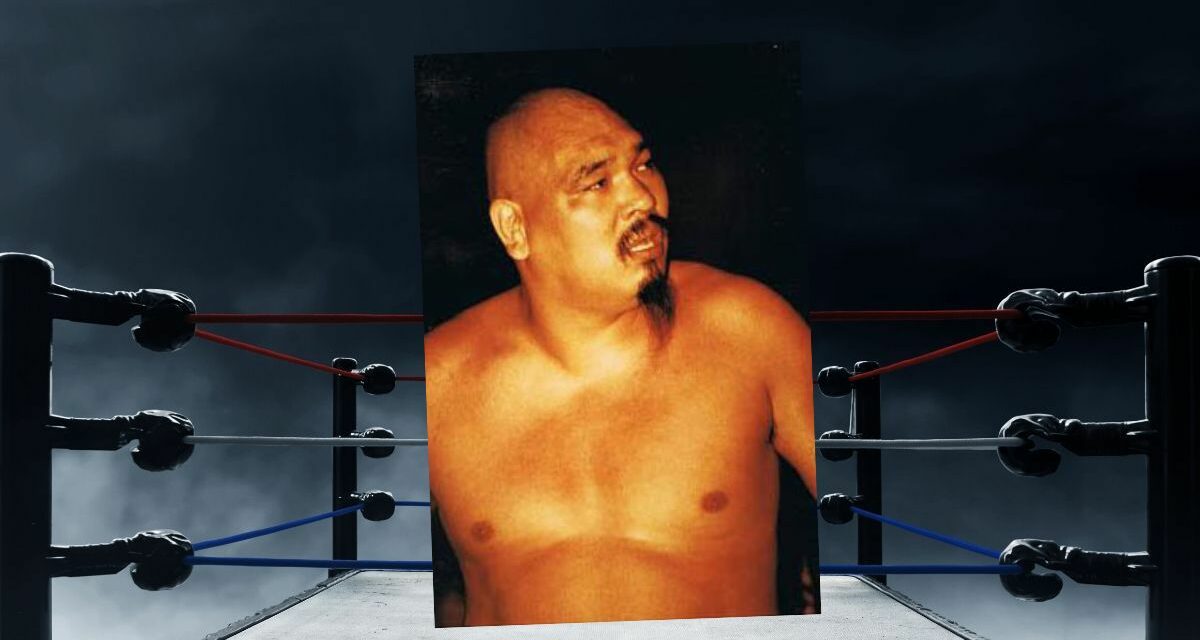Legendary villain Killer Khan (Masashi Ozawa) has died.
In an era where Japanese wrestlers came to North America, learned a different style, and returned to Japan as more complete performers, Khan stayed in the U.S.
He’s on cards from Florida to Louisiana in the 1970s and early 1980s, until moving to the World Wide Wrestling Federation in 1981, where he made a big name for himself after “breaking” Andre the Giant‘s ankle. In demand, Khan continued to travel, his dreaded Oriental Spike a feared weapon.
Then Killer Khan gained even greater notoriety in the WWF, now available internationally, managed by Mr. Fuji, feuding with Hulk Hogan.
“In my opinion, Khan and the Great Kabuki [Akihisa Mera] were the two Japanese who did the best in the States,” wrote Stan Hansen in his autobiography, The Last Outlaw. “Khan had the perfect look for a heel. He had a huge head, and with it shaved, he looked downright scary. More than anything else, he got over due to his look.”
Ozawa himself talked about his life in Listen, You Pencil Neck Geeks, the autobiography of “Classy” Freddie Blassie, written by Keith Elliot Greenberg. “Most of the Japanese wrestlers who’d worked in America before me were relatively short physically. I’m six-foot-five, very tall for a Japanese wrestler. And I have big hands and a big head—a unique look,” Ozawa said. “I could have billed myself as Japanese, but that would have been a throwaway. There was no ‘Mongolian’ wrestler at that time.”
It was Karl Gotch who suggested the gimmick. “He actually drew a sketch of my costume. I had a goatskin vest, and Mongolian hat—a fur hat with a little point on the top. I shaved my head, except I had a small braid hanging down the back,” said Ozawa.
But before he went full Mongolian, Ozawa was born March 6, 1947, in Tsubame, Niigata, Japan. After competing as a sumo wrestling—Koshi Nishiki was his “shikona” name—where he the highest rank he achieved was 40th makushita title.
Ozawa ended up in the JWA to learn to wrestle, starting in 1971. When JWA dissolved, he was in the New Japan Pro Wrestling dojo. During his time learning, Ozawa was able to not only carry future foe Andre the Giant’s bags as a “young boy” doing errands, but he was witness to the infamous Antonio Inoki-Muhammad Ali wrestling versus boxing bout in 1976.
“I was a ‘green boy’ at the time, training at the New Japan dojo,” Ozawa told Greenberg. The future Killer Khan was among Inoki’s entourage at ringside as the bout went to an inconclusive finish.
Sent to North America in 1978, Ozawa was known as Kim Chang in Toronto, though was not ever high up on the cards. (He’d be back in 1981, as a headliner.)
Becoming Killer Khan in Florida in 1979 was the start of something great for Ozawa—and more.
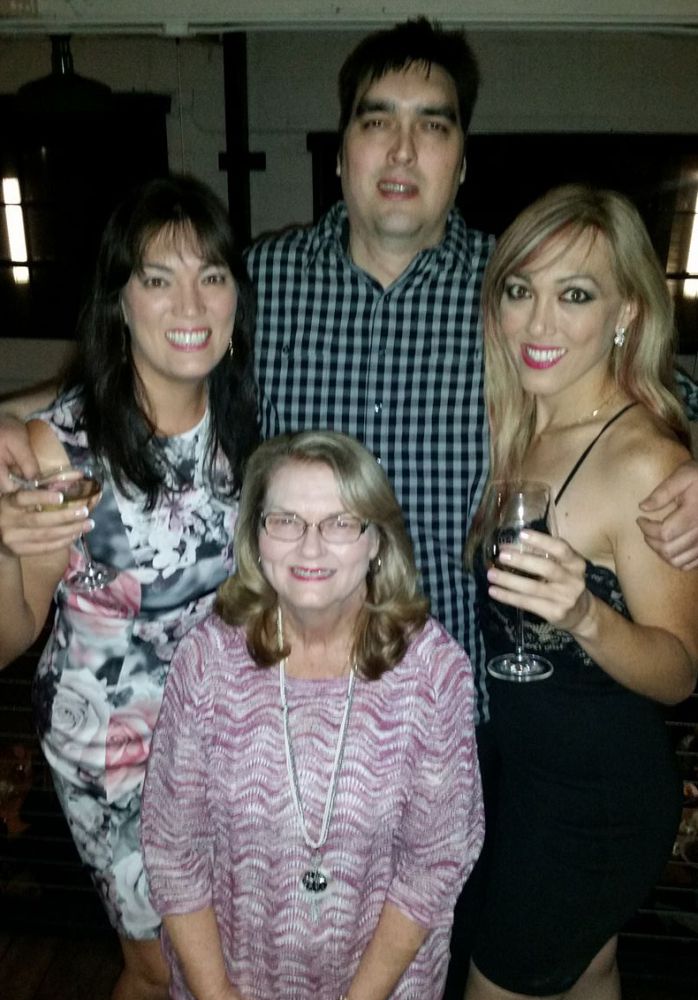
The Ozawa family, from left, Yoshiko, David, and Yukie with their mother, Cindy. Facebook photo
On his old website, Bad News Allen Coage wrote that Killer Kahn “was one of the big stars in my early career with New Japan. The company sent him to work in Mexico and the States, while he was in Florida he met an American girl who tricked him into marrying her. She took him to city hall knowing his English wasn’t good and told him to say yes to everything he was asked and before he knew it he was married.” (Bad News Allen would work with Khan in Stampede Wrestling too in 1983.)
That was Cindy Ozawa, and while the story Coage told may not be totally accurate, it is fun. The couple married in 1975 and had three children, Yukie, Yoshiko, and David Masato.
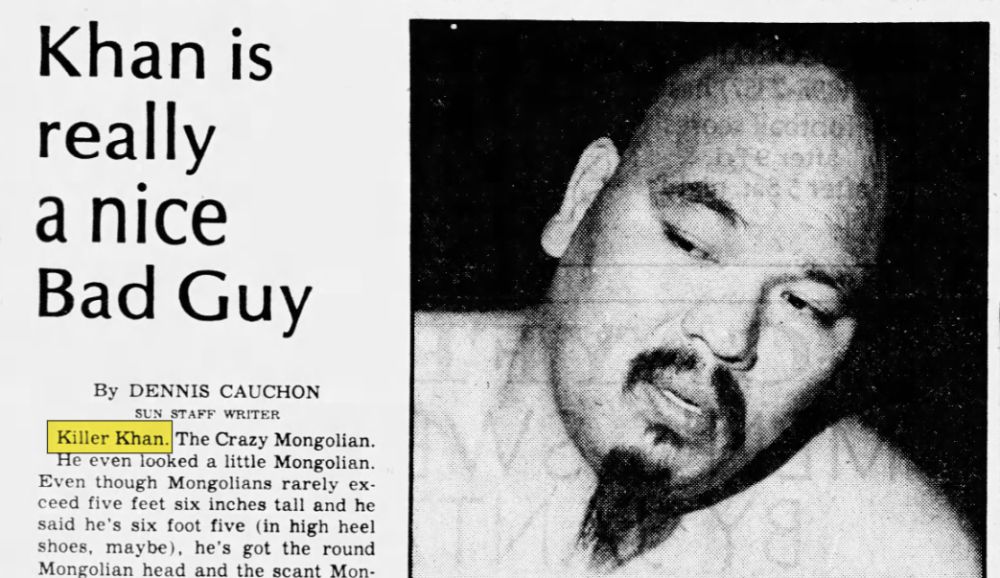
The wife and two kids came up in a fascinating but tongue-in-cheek profile done on Mississippi state champion Killer Khan in the Mississippi Gulf Coast newspaper in September 1982. Writer Dennis Cauchon played along with the gimmick, and Khan’s manager Skandor Akbar was there too. There are some memorable lines in the article:
- “He said his momma is Japanese and his poppa is Mongolian. But that’s about all he said because Killer Khan apparently can’t speak English well.”
- “His handshake was gentle. I shook his small, stubby hand twice to make sure it was the crazy Mongolian. He seemed like a real nice guy.”
- “He turned off his watch and said, ‘I like the United States. It be great country. Only people are crazy.'”
- “Killer’s head needed a shave. Stubble was starting to spring up all over his Telly Savalas-like noggin. He often crossed his arms over his hairless chest or slid his hands into the pockets of the green dress pants he was wearing.”
- “Akbar said Killer has been learning new holds and is willing to show me some. I decline. Killer’s a wimp and he knows it.”
- “[Khan] said he never thinks of taking his good health and money and retiring. ‘My body is still very good. Anyway, I like this business. I make a lot of friends,’ he said. Killer continued to talk but his voice grew softer and more difficult to hear. ‘When I go home (to Japan) I meet senators and movie stars. I’m treated well,” he said.”
Cauchon asks a few regulars at the arena whether Khan spoke English, and they all assured him that he did.
“Killer, you little devil. You Mongolian crazy man, you. You fooled me,” wrote Cauchon. “Now get out of here.”
By most accounts, Ozawa was liked by his wrestling co-workers.
“Killer Khan and I were very close friends, and I’d go to his house, have dinner and visit with him,” recalled Johnny Mantell in 2011. Mantell was also witness to Khan’s feud with the Von Erichs in World Class Championship Wrestling—and witness to Kevin Von Erich’s instinct to get up and fight back instantly instead of selling the moves. “He’d go, ‘Ohh, Kevin, ohh, Kevin. I’ve got to really hold him down, he wants to get up all the time, he wants to get up all the time,'” Mantell recalled Ozawa said. “That was just Kevin’s mentality.” For the record, it was Khan that “taught” the dreaded “Oriental Spike” to Terry Gordy that the Fabulous Freebird would use on the Von Erichs.
It was Blassie who taught Khan to slow it down and take fewer bumps. “Sometimes, twisting your face and groaning like you’re in pain is more effective than a bump,” Blassie told Khan.
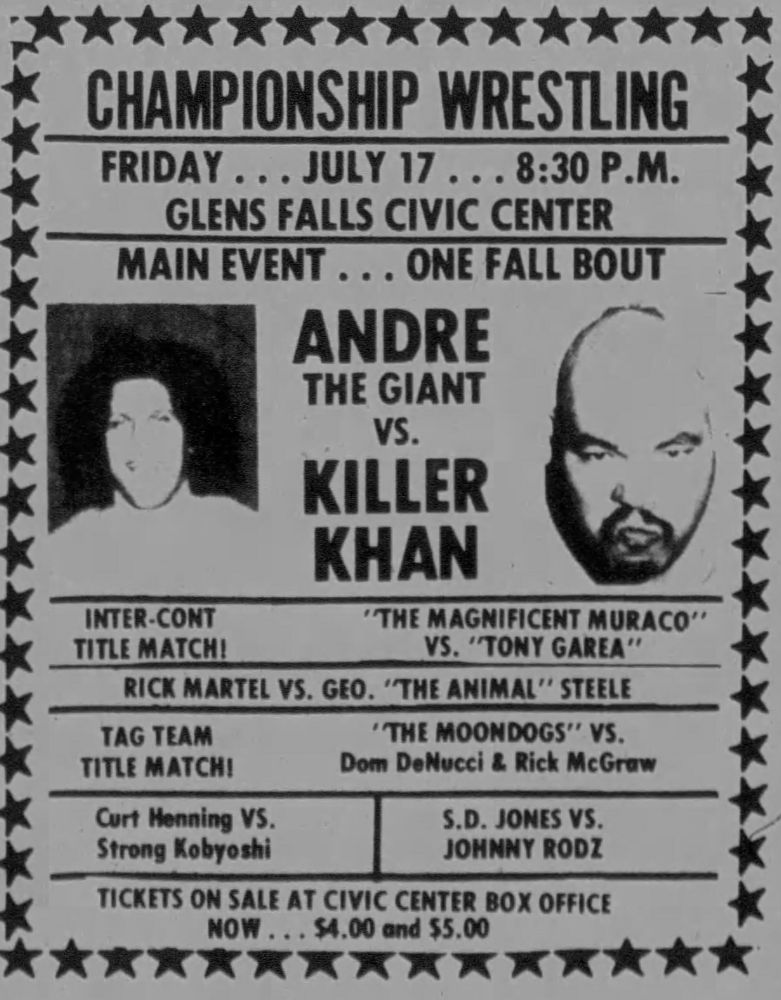
WWWF in Glens Falls, NY, on July 17, 1981.
Blassie was Killer Khan’s manager in the WWWF in 1981-82, when the bad break turned good happened.
It was May 1981, and, while in reality Andre the Giant had broken his ankle getting out of bed, it was used for an angle.
“I wanted to kneedrop Andre’s chest. But he started to get up, and I landed on his ankle. This wasn’t an angle. Even though Andre was a big guy, I weighed three hundred pounds. If you drop that kind of weight on someone’s ankle, it’s going to break. Right away, Vince McMahon, Sr. decided to take advantage of the circumstances. He said, ‘Let’s use this injury to draw business,'” said Ozawa in Blassie’s book.
Blassie worked his magic on the microphone, taunting the then semi-retired announcer Pat Patterson into coming back to action. “Because Khan couldn’t speak English, he didn’t say a word. He darted his head from side to side, twisted his face, and stared at the ceiling like a madman, while I did the talking,” wrote “The King of Men.”
Andre the Giant, playing along with the storyline, described the break to Tulsa World writer Glenn Hibdon in July 1982: “Khan wanted to give me a knee drop to the throat,” said Andre. “I moved and he missed my throat and landed on my ankle. That’s the first and only time I’ve been hurt. I’ve never been pinned. Khan broke my leg, and he didn’t beat me. I finished with the broken leg. He said he beat me, but that’s not true.”
It created a feud that lasted for years—winning Feud of the Year from Pro Wrestling Illustrated—and made Khan a Killer with a series of Mongolian Stretcher Matches unconfined to a single territory.
“When Andre and I finally got in the ring together, we worked pretty stiff. We hit each other with very hard chops, and the matches were very believable. If I went loose on Andre, he’d get mad and give me a good hard one, and say, ‘Come on! What are you doing? Let’s go!'” Ozawa said in Blassie’s book. “There’s one episode I remember where I was really exhausted and lying on the mat, flat out, straight up, looking at the ceiling. And here comes Andre with this humongous ass, and he just sat on my face. At that moment, I actually thought that I was going to die.”
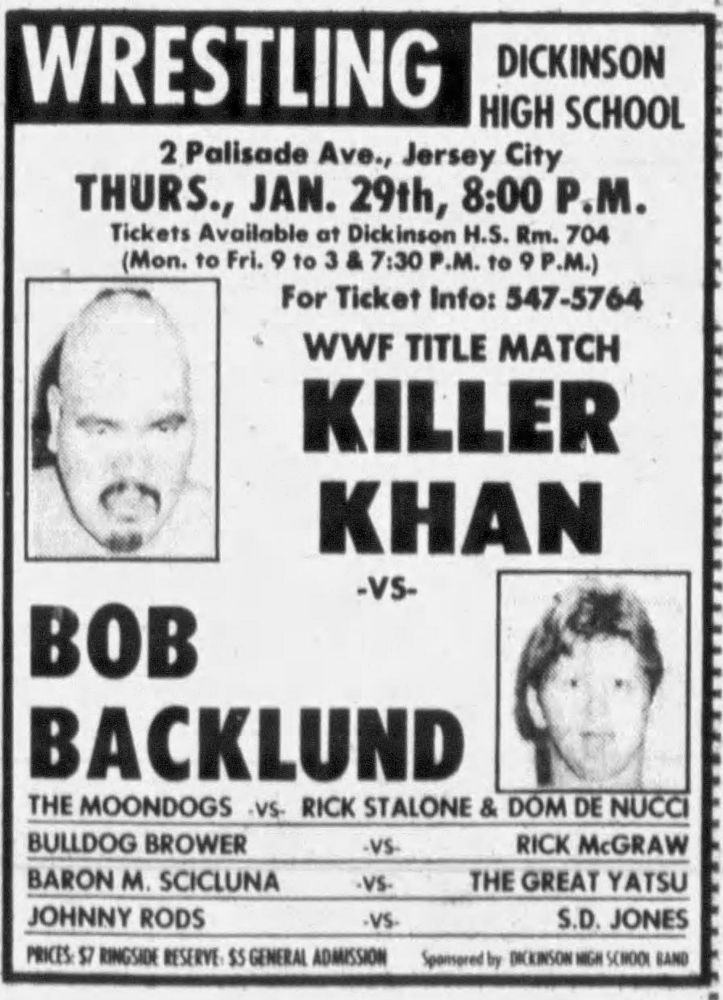
WWWF in Jersey City, NJ, on Jan. 29, 1981
Besides fighting with Andre in WWWF, Khan teamed with Strong Kobayashi frequently, challenging for the tag team titles, and took on Bob Backlund for the WWWF World title.
Ozawa didn’t like one aspect of his gimmick. “In the World Wrestling Federation, I was also told to spit out this green spew, and ‘blind’ my opponents with it. I didn’t like that very much because I take a lot of pride in my wrestling technique. Winning a match with green spew is like winning a match by breaking a beer bottle over somebody’s head. In my mind, even a mark could win against a wrestler with a beer bottle,” he told Greenberg.
Killer Khan’s battles with Archie “The Stomper” Gouldie in Stampede Wrestling in 1984 are the stuff of legend, as Gouldie was “The Mongolian Stomper” everywhere else in wrestling. Khan held the promotion’s top belt, the North American title.
As for his time in Japan as a wrestler, it was more akin to the other gaijins who came in for a specific amount of time, a short tour or a couple of months, and then returned home to wrestle. The New Japan website noted that his “Mongolian Chops” were later adopted by Hiroyoshi Tenzan, Great-O-Khan and others. The NJPW obit on Khan also added that, in 1983, “Khan joined Riki Choshu in Choshu’s influential Ishingun faction. From there, he would follow Choshu to Japan Pro-Wrestling in 1985, wrestling in the All Japan ring as a result as well as back in the WWF.”
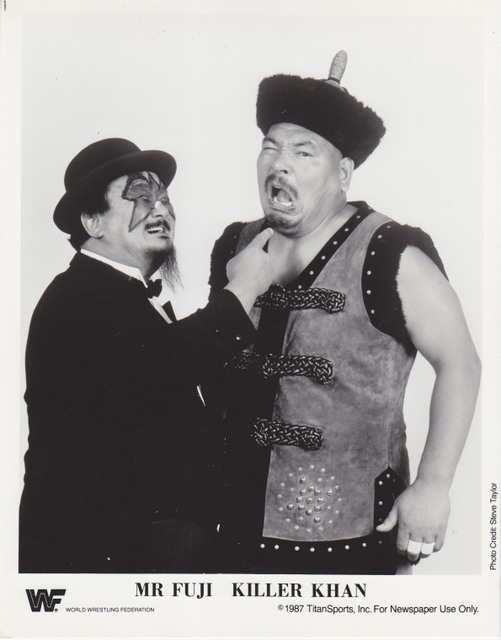
Mr. Fuji and Killer Khan in WWF.
The last run of Killer Khan was in 1987, when he returned to the WWF, this time managed by Mr. Fuji. The foreign menace feuded with Outback Jack, and then got a run against WWF World champion Hulk Hogan.
Ozawa would retire by the end of 1987.
Away from the ring, Ozawa can be seen in small roles in a few movies, including 3 Ninjas Kick Back, Lion-Maru G, Ebarake no hitobito (1991) and Maju toshi 9-1 II (1996).
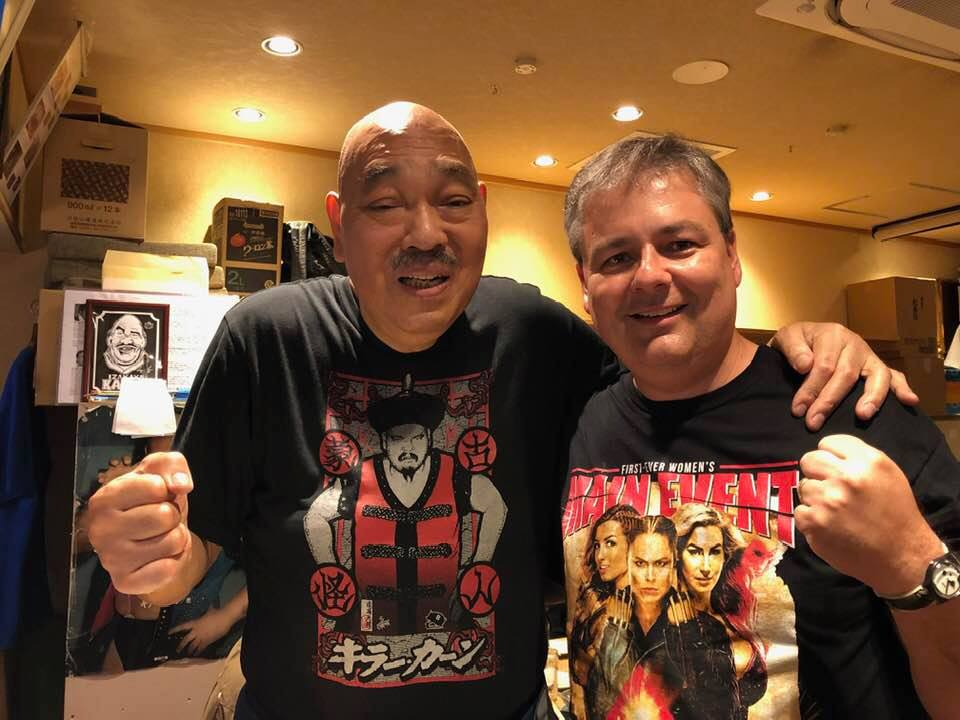
Masashi Ozawa and fan Joseph Edward in 2019. Courtesy Joseph Edward.
Through the years, many fans made the pilgrimage to his restaurants in Shinjuku, a major commercial and administrative area in Tokyo. He was always happy to chat about pro wrestling.
“R.I.P. Killer Khan San who passed away today at the age of 76,” posted Harry Smith to social media. “I went to Killer Khan Chanko restaurant a couple times and had good chats with him about Calgary, and he also lived in Land O Lakes FL where I grew up too. And he told me Karl Gotch stories also. Huge man he was too, and very nice guy, good chanko hot pot!”
Ozawa had a few recent health issues, and announced that he had colon cancer in March 2022, and had surgery.
According to reports, on December 29, 2023, he collapsed at his restaurant, and was rushed to hospital, where he died. It is believed that an aortic dissection caused his death.
RELATED LINK
